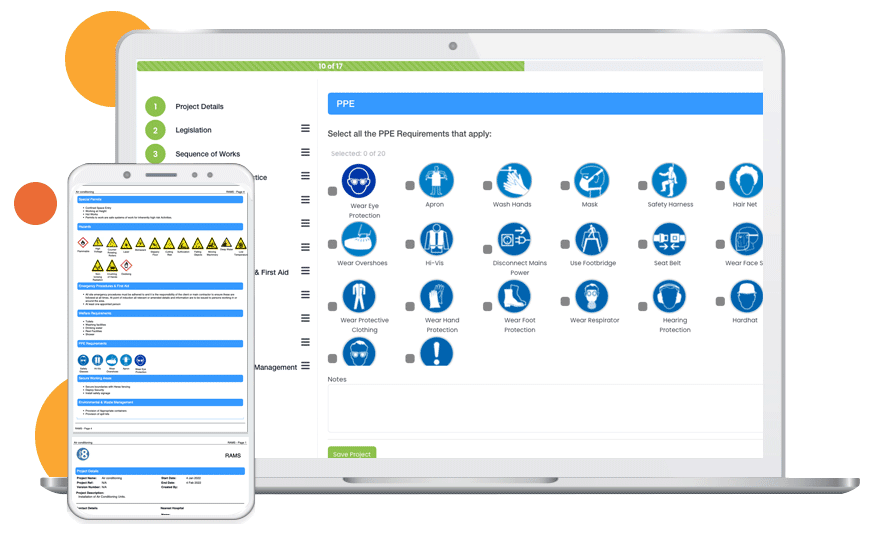Risk assessments and method statements are essential components of any occupational health and safety program. They help organizations identify and evaluate potential hazards in the workplace, as well as implement control measures to minimize the risk of accidents and injuries. However, the process of conducting risk assessments and creating method statements can be time-consuming and cumbersome. In this article, we will explore the key components of effective risk assessments and method statements, as well as provide tips on how to streamline the process for maximum efficiency.
The Importance of Streamlining
While risk assessments and method statements (RAMS) are critical components of any occupational health and safety program, the process of conducting them can be time-consuming and bureaucratic. This can result in frustration, delays, and reduced efficiency. Streamlining the risk assessment and method statement process can help organizations save time, increase productivity, and improve overall safety performance.
One way to streamline the process is to use technology to automate the risk assessment and method statement process. This may involve using software to identify hazards, assess risks, and generate method statements automatically. By automating these processes, organizations can save time and reduce the risk of errors or omissions.
Effortlessly create RAMS in a few clicks With Evalu-8 EHS
Quick and easy RAMS creation and documentation with Evalu-8 EHS’s streamlined approach to risk management. Save time, gain real-time insights, and effortlessly produce detailed shareable RAMS documents.

Another way to streamline the process is to involve employees in the risk assessment and method statement process. By empowering employees to identify hazards and assess risks, organizations can improve the quality of risk assessments and method statements, as well as increase employee engagement and ownership of the safety program.
In conclusion, risk assessments and method statements are essential components of any occupational health and safety program. By identifying hazards, assessing risks, and implementing control measures, organizations can ensure that work is conducted safely and efficiently. By streamlining the risk assessment and method statement process, organizations can save time, increase productivity, and improve overall safety performance.
Key Components of Effective Risk Assessments and Method Statements
Identifying Hazards
The first step in conducting a risk assessment or creating a method statement is to identify potential hazards. This includes physical, chemical, biological, and ergonomic hazards, as well as safety risks such as falls, electrical hazards, and fire hazards. It is essential to conduct a thorough evaluation of the workplace and task requirements to identify all relevant hazards.
Evaluating Risks
Once hazards have been identified, it is important to evaluate the risks associated with each one. This involves assessing the likelihood and severity of potential harm, as well as considering any existing control measures that are in place. This information is used to determine the level of risk and prioritize the implementation of control measures.
Implementing Control Measures
The next step is to implement control measures to minimize the risk of accidents and injuries. This includes engineering controls such as physical barriers and ventilation systems, administrative controls such as work procedures and training, and personal protective equipment such as gloves and respirators. Control measures should be effective, practical, and proportionate to the level of risk.
Monitoring and Reviewing
Finally, it is important to monitor and review the effectiveness of the control measures that have been implemented. This involves regularly assessing workplace conditions, evaluating the implementation of control measures, and making adjustments as necessary. Monitoring and reviewing the risk assessment and method statement process is key to ensuring ongoing safety and efficiency.
Streamlining the Process
Utilising Technology and Software
One way to streamline the risk assessment and method statement process is to utilize technology and software. There are a variety of software solutions available that can help organizations automate the risk assessment and method statement process, including online forms, checklists, and databases. These solutions can significantly reduce the time and effort required to conduct risk assessments and create method statements.
Standardizing Templates and Formats
Another way to streamline the process is to standardize templates and formats. By creating standardized templates and formats for risk assessments and method statements, organizations can reduce the time and effort required to create new documents. This also ensures consistency and accuracy across all documents, making them easier to understand and interpret.
Implementing a Centralized System
Finally, implementing a centralized system for managing risk assessments and method statements can help organizations improve efficiency and reduce duplication. By centralizing the management of risk assessments and method statements, organizations can ensure that all documents are up-to-date and easily accessible. This can help reduce the time and effort required to locate and manage documents, as well as improve overall efficiency.
Enhancing Collaboration and Communication
Involving Key Stakeholders
Collaboration and communication are essential components of any successful risk assessment and method statement process. To enhance collaboration and communication, organizations should involve key stakeholders, including employees, managers, and health and safety professionals. This ensures that all perspectives are considered and that everyone is working towards a common goal.
Encouraging Open Dialogue
Another way to enhance collaboration and communication is to encourage open dialogue. This involves creating an environment where employees feel comfortable sharing their thoughts and opinions on the risk assessment and method statement process. Regular meetings and feedback sessions can help facilitate this dialogue and ensure that all stakeholders are engaged and aware of their roles and responsibilities.
Establishing Clear Roles and Responsibilities
Finally, it is important to establish clear roles and responsibilities for all stakeholders involved in the risk assessment and method statement process. This helps ensure that everyone understands their role and knows what is expected of them. Clear roles and responsibilities also make it easier to delegate tasks and hold individuals accountable for their actions.
Conclusion
Streamlining the risk assessment and method statement process is essential for maximizing efficiency and improving overall safety performance. By understanding the key components of effective risk assessments and method statements, and implementing strategies to streamline the process, organizations can save time, reduce bureaucracy, and enhance collaboration and communication. By working together towards a common goal, organizations can ensure that their employees remain safe and healthy, and that the workplace remains productive and efficient.
See Evalu-8 EHS in action
The leading choice of EHS software for small to large companies in the manufacturing sector that want to get control of there safety



